Troubleshooting. Attachment not fitting in the aligner
by
simona
Troubleshooting
Solution
Don’t force the aligner into place over the misaligned engager (this can move the tooth in unwanted ways)
Instead, try the following:
- Remove the attachment that’s not fitting in the aligner, and use the previous aligner as a template to place a new engager on that same tooth.
- Check for tight contacts that may be preventing movement.
- Try backtracking with the previous aligner, the teeth may just need more time to make the needed movement.
- If the aligner fits everywhere else, remove the engager that isn’t fitting into the aligner and continue with treatment. That particular tooth may not move as scheduled on the treatment plan, but the movement can be completed later with a revision at the end of treatment or by using auxiliaries or dimples.
- If all else fails, remove the engagers from all of the teeth, take new upper and lower impressions, and request a case revision. This may delay treatment, but it will allow you to adjust the treatment plan for that particular tooth.
Gap in the aligner
Though the attachment will still apply pressure to the tooth and work toward completing that difficult movement, there may be a slight gap in the aligner because that tooth will be moving a little behind schedule. (In the meantime, Chewies may help close those gaps.)























